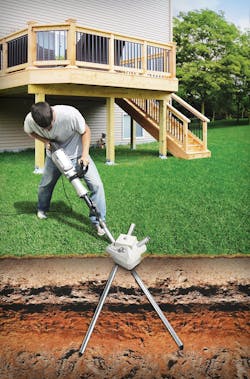How much time would you save if you didn’t have to worry about excavation every time you built a deck foundation? What if there was a product that let you place footings and build the framing, all in the same day?
Washington-based Pin Foundations’ founder, Rick Gagliano, created Diamond Pier as the answer to these questions. The system replaces traditional footings with steel pins that are driven into the earth. The pins support the deck’s weight, and create a stable foundation for uplift forces, such as frost heave, as well as expansive soils.
Diamond Pier consists of a proprietary concrete head that anchors the four pins. Installers start by digging a hole that can accommodate the head up to its midpoint. “They’re almost 80% lighter than the same chunk of concrete that would traditionally serve as the footing,” says Gagliano. “That weight reduction makes it easier on the installers, and lowers the amount of fuel needed for transport to the jobsite.”
The soil directly under the concrete head doesn’t actually shoulder any of the load. Instead, the head’s only functions are to hold the pins in place and transfer loads between the pins and the deck post.
Once the head is placed, the piles are driven into four pre-drilled, angled holes, one on each face of the head. By driving the pins in on an angle, Diamond Pier creates an A-shaped cone that distributes the structure’s load over a greater area of soil—reminiscent of a tree’s intricate root system that bears the weight of the tree over a much greater surface area than the trunk provides.
It’s a two-man job, with one person ensuring the head remains in place and level while the other drives the pins in a few inches at a time. A sledgehammer can be used for the first few inches, but a handheld automatic driving hammer with a 11/8” hex shaft driving bit is needed to drive the pins into deeper, more tightly packed soil.
The concrete head also serves as a pin piling lock: It secures the pins when a load is applied from any direction, increasing the footing’s strength and stability. This, coupled with the spread-out design of the pins, allows the Diamond Pier to work well in expansive soils and in parts of the country with a lot of frost heave, says Gagliano. And, perhaps most importantly, Diamond Piers cut the amount of time needed for installation. “We’ve found builders tend to spend the same in materials, but around half the amount in labor,” says Andrea Munday, marketing coordinator and internet media manager for Diamond Pier, “not just because of the speed of install, but because of not needing to wait for a hole inspection or for concrete to set.”
Once the head is placed, the piles are driven into four pre-drilled, angled holes, one on each face of the head.
Pin Foundations offers four Diamond Pier models, each an equivalent alternative to traditional concrete piers. Pins are available in 36”, 42”, 50”, or 63” lengths, with diameters varying from 1-2”, depending on the size of the concrete head. The company can also accommodate site-specific engineering for larger projects or additions. (The off-the-shelf models are not suitable for these types of jobs.)

